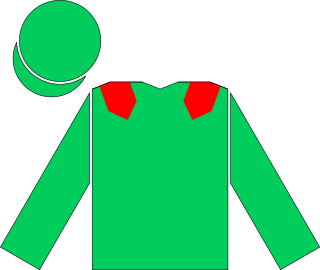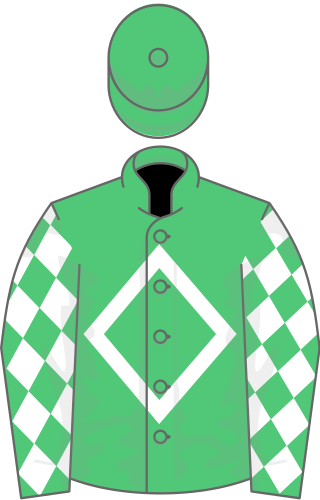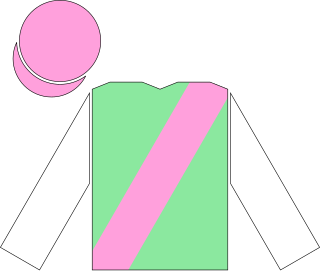
Shahrastani (1983–2011) was an American-bred, British-trained Thoroughbred racehorse. He won four of his seven races between September 1985 and October 1986. He is best known for his performances in the summer of 1986 when he defeated Dancing Brave in the Epsom Derby and went on to win the Irish Derby by eight lengths. At the end of the season he was retired to stud, but made little impact as a stallion. He died in 2011.

Henbit was an American-bred and British-trained Thoroughbred racehorse, best known for winning the Derby in 1980. After winning one minor race as a two-year-old, he showed improved form in 1980 to win the Classic Trial Stakes and the Chester Vase. He won the Derby in a fast time but sustained a leg injury in the race which ruled him out for the rest of the year. He failed when returning as a four-year-old and was retired to stud, where he had limited success as a sire of winners.

Shadeed (1982–2005) was an American-bred, British-trained Thoroughbred racehorse and sire. In a career that lasted from October 1984 to November 1985, he ran seven times and won four races. In 1985, he was the highest-rated three-year-old in Europe over one mile when he won the 2000 Guineas and the Queen Elizabeth II Stakes. On his final start he became the first winner of a British Classic to compete in the Breeders' Cup when he took third place in the Breeders' Cup Mile at Aqueduct Race Track.

Doyoun was a British Thoroughbred racehorse and sire, best known for winning the classic 2000 Guineas in 1988. In a racing career which lasted from October 1987 until October 1988 he ran seven times and won three races. After winning his only race as a two-year-old in 1987, Doyoun produced his most impressive performance on his three-year-old debut when he defeated Warning in the Craven Stakes. He won the 2000 Guineas on his next appearance but failed to win again, although he did finish third in The Derby. He was retired to stud at the end of the season, and after a slow start to his breeding career, sired several important winners including Daylami and Kalanisi. He died in Turkey in 2002.
Shardari was an Irish-bred, British-trained Thoroughbred racehorse and sire. He was unraced as a two-year-old before winning four of his six races as a three-year-old in 1985 including the Cumberland Lodge Stakes and St. Simon Stakes. In the following year he was tried at the highest level, winning the Princess of Wales's Stakes and International Stakes and finishing second to Dancing Brave in the King George VI and Queen Elizabeth Stakes. He was retired to stud at the end of 1986 but had little success as a sire of winners.
Ajdal was an American-bred, British-trained Thoroughbred racehorse and sire. He was one of the leading European two-year-old of 1986, when he was unbeaten in three races including the Dewhurst Stakes. In the early part of 1987 he was aimed at the classics but after winning the Craven Stakes on his debut, he was beaten in the 2000 Guineas, Irish 2,000 Guineas and Epsom Derby. He was then switched to shorter distances and emerged as the best European sprinter of the year, winning the July Cup, William Hill Sprint Championship and Vernons Sprint Cup.
Sonic Lady was an American-bred, British-trained racehorse and broodmare. A temperamental filly who was often difficult to ride, she was a specialist miler who won seven Group races. After winning her only race as a two-year-old, she won the Nell Gwyn Stakes in April 1986, but was beaten into third place when favourite for the 1000 Guineas. She then won her next five races: the Irish 1,000 Guineas, Coronation Stakes, Child Stakes, Sussex Stakes and Prix du Moulin and was rated the best filly of her generation in Europe. She stayed in training as a four-year-old in 1987 and won a second Child Stakes. She was twice the beaten favourite in the Breeders' Cup Mile. Retired to stud at the end of 1987, she had some success as a broodmare.
Cut Above was a British Thoroughbred racehorse and sire best known for his upset win in the 1981 St Leger Stakes. As a two-year-old he showed useful form despite being beaten in both of his races and won the White Rose Stakes on his three-year-old debut. After recovering from a viral infection he finished second to Shergar in the Irish Derby and third to Ardross in the Geoffrey Freer Stakes. In the St Leger he started a 28/1 outsider but won from Glint of Gold and Bustomi with the odds-on Shergar in fourth. After being well-beaten in his only subsequent race he stood as a breeding stallion in Ireland and Brazil.

Glint of Gold was a British Thoroughbred racehorse and sire. A middle-distance specialist, he was noted for his toughness and consistency, winning ten races, finishing second six times and third once in a seventeen race career which lasted from July 1980 until September 1982. He won races in four countries including six at Group One level. His major victories included the Gran Criterium and Derby Italiano in Italy, the Grand Prix de Paris and Grand Prix de Saint-Cloud in France, the Preis von Europa and Grosser Preis von Baden in Germany and the Great Voltigeur Stakes and John Porter Stakes in Britain. He was also placed in The Derby, St Leger Stakes, Coronation Cup and King George VI and Queen Elizabeth Stakes. He was retired to stud at the end of the 1982 season and had modest success as a sire of winners.
Vayrann was an Irish-bred, French-trained Thoroughbred racehorse and sire. As a three-year-old in 1981 he won four of his six races including the Prix Jean de Chaudenay, Prix du Prince d'Orange and Champion Stakes. His victory in the latter race was only confirmed at the end of a protracted and controversial process after he failed a post-race drug test. He was injured on his second appearance in 1982 and was retired to stud, where he had moderate success as a sire of winners.
Fairy Footsteps was a British Thoroughbred racehorse and broodmare best known for winning the classic 1000 Guineas in 1981. She showed promise in her first two races as a two-year-old before establishing herself as one of the best fillies of her generation with an emphatic win in the Waterford Candelabra Stakes. In the spring of 1981 she was heavily backed for the 1000 Guineas before and after a win in the Nell Gwyn Stakes. She won the 1000 Guineas by leading all the way and was considered highly likely to follow up with a win in the Epsom Oaks but was retired after a disappointing defeat in the Musidora Stakes. She had some success as a broodmare.

Blue Wind was an Irish Thoroughbred racehorse and broodmare best known for winning the classic Oaks Stakes in 1981. She showed promising form as a two-year-old in 1980 when she won two of her five races including the Silken Glider Stakes. In the following year she finished second in the Irish 1,000 Guineas and then showed her best form when moved up in distance, winning the Oaks by seven lengths and following up in the Irish Oaks a month later. In 1982 she was campaigned in the United States without success. She made no impact as a broodmare.
Little Wolf was a British Thoroughbred racehorse and sire. He was best known for his performances in staying races, but was also capable of winning important races over middle distances. Little Wolf was lightly campaigned, running sixteen times between October 1980 and May 1984 and winning seven races. After winning his only race as a two-year-old he won two of his five races including the Scottish Derby and St Simon Stakes in 1981. In the following year he won the Prix Jean de Chaudenay in France before establishing himself as a high-class stayer with an emphatic win in the Jockey Club Cup. In 1983 he won Britain' most prestigious long-distance race, the Gold Cup at Royal Ascot and followed up with a record-breaking win in the Goodwood Cup. He was injured in his only subsequent race and was retired to stud where he made no impact as a sire of winners.
Light Cavalry was a British Thoroughbred racehorse and sire best known for winning the classic St Leger Stakes in 1980. After winning his only race as a two-year-old, Light Cavalry was one of the best three-year-olds in Britain in 1980, winning the King Edward VII Stakes and being placed in the Chester Vase, Gordon Stakes and Great Voltigeur Stakes before winning the St Leger by four lengths. He remained in training in 1981 and won the Princess of Wales's Stakes, but his season was restricted by injury problems. After his retirement from racing he stood as a breeding stallion in the United States and Argentina with limited success.
Madam Gay was a British Thoroughbred racehorse. She showed some promise as a two-year-old in 1980 before developing into a top-class middle distance performer in the following year. Her only victory in a thirteen race career came when she won the Prix de Diane in 1981, but she was placed in many important races including the Oaks Stakes, King George VI and Queen Elizabeth Stakes, Arlington Million and Prix Vermeille. Having been originally bought for 8,000 guineas she was eventually sold for a reported $1.4 million.
Tyrnavos was a British Thoroughbred racehorse and sire, best known for his win in the 1980 Irish Derby. As a two-year-old he showed promise by winning one of his three races and finishing second in the Dewhurst Stakes. In the following year he won the Craven Stakes, but was well-beaten in the 2000 Guineas, Dante Stakes and Epsom Derby, before recording a 25/1 upset victory the Irish Derby at the Curragh Racecourse. He was retired to stud at the end of the year and had limited success as a sire of winners.
The 1981 Epsom Derby was the 202nd annual running of the Derby horse race. It took place at Epsom Downs Racecourse on 3 June 1981.

The 2005 King George VI and Queen Elizabeth Stakes was a horse race held at Newbury Racecourse on Saturday 23 July 2005. It was the 55th King George VI and Queen Elizabeth Stakes. The race was run at Newbury as Ascot Racecourse, the event's traditional home, was being redeveloped. Whereas Ascot is a right-handed, triangular course with a short straight, Newbury is a wide, left-handed oval with a five furlong straight, giving the race a very different complexion.

The 2003 King George VI and Queen Elizabeth Stakes was a horse race held at Ascot Racecourse on Saturday 26 July 2003. It was the 53rd King George VI and Queen Elizabeth Stakes.

The 1986 King George VI and Queen Elizabeth Stakes was a horse race held at Ascot Racecourse on Saturday 26 July 1986. It was the 36th running of the King George VI and Queen Elizabeth Stakes.






